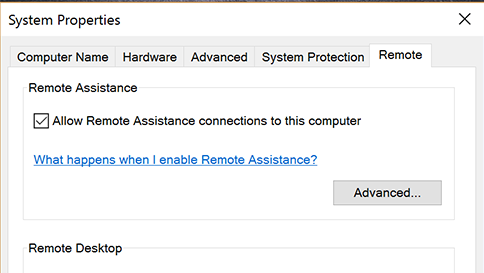Important: Learn how to protect yourself from tech support scams. Tech support scams are an industry-wide issue where scammers use scare tactics to trick you into unnecessary technical support services. Only allow a Helper to connect to your device if you initiated the interaction by contacting Microsoft Support directly. If you or someone you know has been affected by a tech support scam, use the technical support scam form to report it.
Windows Remote Assistance lets someone you trust take over your PC and fix a problem from wherever they are.
Tip: You can also use Quick Assist to give and receive remote assistance.
Before you can use it, you'll need to enable access. In the search box on the taskbar, type remote assistance, and then select Allow Remote Assistance invitations to be sent from this computer from the list of results. Then, on the Remote tab, select the Allow Remote Assistance connections to this computer check box, and then select OK.

To get help:
-
In the search box on the taskbar, type remote assistance again and select Invite someone to connect to your PC and help you, or offer to help someone else.
-
Select Invite someone you trust to help you.
-
Do one of the following:
-
If you've never used Easy Connect, select Use Easy Connect.
-
If you've used Easy Connect before, select your helper’s contact name. To invite someone who isn't on your contact list, select Invite someone to help you.
-
-
Follow the instructions.
To give help if someone has requested it:
-
Go to the search box and enter remote assistance, then select Invite someone to connect to your PC and help you, or offer to help someone else.
-
Select Help someone who has invited you.
-
Do one of the following:
-
If you’re using Easy Connect for the first time, select Use Easy Connect.
-
If you’ve used Easy Connect before, select the contact name of the person you want to help. To help someone not on the list, tap or click Help someone new.
-
-
Follow the instructions.










